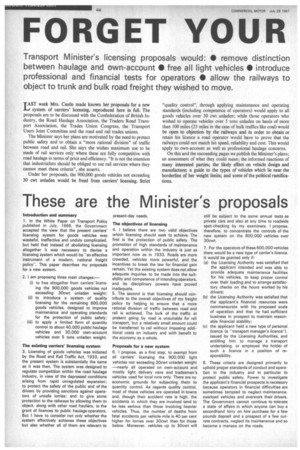These are the Minister's proposals
Page 46

If you've noticed an error in this article please click here to report it so we can fix it.
Introduction and summary
1. In the White Paper on Transport Policy published in July, 1966, the Government accepted the view that the present carriers' licensing system for goods vehicles was wasteful, ineffective and unduly complicated, but held that instead of abolishing licensing altogether it was necessary to devise a licensing system which would be -an effective instrument of a modern, national freight policy". This paper describes my proposals for a new system.
2. I am proposing three main changes:—
(ii to free altogether from carriers' licensing the 900,000 goods vehicles not exceeding 30cwt unladen weight; (ii) to introduce a system of quality licensing for the remaining 600,000 goods vehicles, designed to improve maintenance and operating standards for the protection of public safety: (iii) to apply a limited form of quantity control to about 40,000 public haulage vehicles and 30,000 own-account vehicles over 5 tons unladen weight.
The existing carriers' licensing system 3. Licensing of goods vehicles was initiated by the Road and Rail Traffic Act, 1933, and the present system is substantially the same as it was then. The system was designed to regulate competition within the road haulage industry, in view of the depressed conditions arising from rapid unregulated expansion; to protect the safety of the public and of the drivers by providing sanctions against operators of unsafe lorries: and to give some protection to the railways by allowing them to object, along with other road hauliers, to the grant of licences to public haulage operators. But I have to consider not only whether the system effectively achieves these objectives but also whether all of them are relevant to present-day needs.
The objectives of licensing 4. I believe there are two valid objectives which licensing should seek to achieve. The first is the protection of public safety. The promotion of high standards of maintenance and operation within the industry is just as important now as in 1933. Roads are more crowded, vehicles more powerful, and the incentives to break the law for financial gain remain. Yet the existing system does not allow adequate inquiries to be made into the suitability and competence of intending operators, and its disciplinary powers have proved inadequate.
5. The second is that licensing should contribute to the overall objectives of my freight policy by helping to ensure that a more rational division of traffic between road and rail is achieved. The bulk of the traffic at pretent going by road is unsuitable for rail transport, but a relatively small amount could be transferred to rail without imposing additional costs on industry and with benefit to the economy as a whole.
Proposals for a new system 6. I propose, as a first step, to exempt from all carriers' licensing the 900,000 light vehicles not exceeding 30cwt unladen weight —nearly all operated on own-account and mostly light delivery vans and tradesmen's vehicles used for local runs only. There are no economic grounds for subjecting them to quantity control. As regards quality control, most of these vehicles are operated in towns and, though their accident rate is high, the accidents in which they are involved tend to be less serious than those involving heavier vehicles. Thus, the number of deaths from fatal accidents per vehicle-mile is 40 per cent higher for lorries over 30cwt than for those below. Moreover, vehicles up to 30cwt will still be subject to the same annual tests as private cars and also at any time to roadside spot-checking by my examiners. I propose, therefore, to concentrate the controls of the new system on the 600,000 vehicles over 30cwt.
7. For the operators of these 600,000 vehicles there would be a new type of carrier's licence. It would be granted only if: (a) the Licensing Authority was satisfied that the applicant intended and was able to provide adequate maintenance facilities for his vehicles, to keep proper control over their loading and to arrange satisfactory checks on the hours worked by his drivers; lb) the Licensing Authority was satisfied that the applicant's financial resources were commensurate with his proposed scale of operation and that he had sufficient business in prospect to maintain reasonable financial stability; (c) the applicant held a new type of personal licence (a "transport manager's licence"), issued by the Licensing Authorities, and entitling him to manage a transport undertaking, or employed the holder of such a licence in a position of responsibility.
8. These criteria are designed primarily to uphold proper standards of conduct and operation in the industry and in particular to protect public safety. Power to investigate the applicant's financial prospects is necessary because operators in financial difficulties are sometimes tempted to neglect maintenance, overload vehicles and overwork their drivers. The Government cannot continue to tolerate a state of affairs in which anyone can buy a secondhand lorry on hire purchase for a few pounds deposit and a prospect of a few cutrate contracts, neglect its maintenance and so become a menace on the roads.




































































































































































